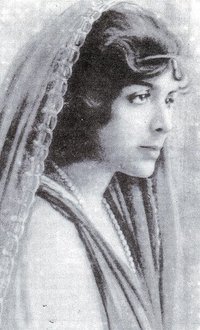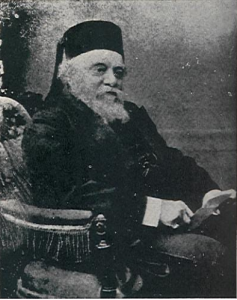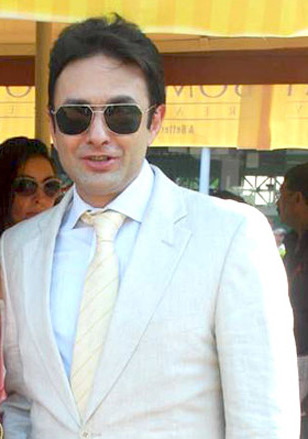Related Research Articles

Jehangir Ratanji Dadabhoy Tata was a French-Indian Aviator, Business magnate, Entrepreneur and chairman of Tata Group.

Rattanbai Jinnah, also known as Ruttie Jinnah, was the wife of Muhammad Ali Jinnah, an important figure in the creation of Pakistan and the country's founder.

Dina Wadia was the daughter of Muhammad Ali Jinnah, the founding father of Pakistan, and Rattanbai Petit. She belonged to some of the most prominent families of the Indian subcontinent, notably, the Jinnah family through her father, the Petit family through her mother, and the Wadia family through her marriage to Neville Wadia.

Nusli Neville Wadia is an Indian billionaire businessman and the chairman of the Wadia Group, an Indian conglomerate involved in the FMCG, textiles and real estate industries among others. His net worth was estimated at US$4.1 billion by Forbes in August 2021.

Sir Dinshaw Maneckji Petit, 1st Baronet was an Indian entrepreneur and founder of the first textile mills in India, as well as a great philanthropist. He was part of the Petit family and became the first Petit baronet.
Bombay Dyeing & Manufacturing Company Limited is an Indian textile company headquartered in Mumbai, India. It operates as a subsidiary of the Wadia Group and is one of India's largest producers of textiles.
Lovji Nusserwanjee Wadia (1702–1774) was a Parsi from Surat province of Gujarat in India and was a member of the Wadia family of shipwrights and naval architects, who founded Wadia Group in 1736.
Neville Ness Wadia was an Indian businessman, philanthropist and a member of the Wadia family, an old Parsi family which, by the 1840s, was one of the leading forces in the Indian shipbuilding industry. Wadia was the last of India's aristocratic taipans, who expanded his family textile concern into one of India's largest and donated lavishly for the welfare of the Parsee community to which he belonged.

Wadia Group is an Indian multinational conglomerate, founded in Surat, headquartered in Mumbai. It was founded by Lovji Nusserwanjee Wadia in 1736 and is the oldest company in India, with its subsidiary The Bombay Burmah Trading Corporation Limited, established in 1863, being the oldest publicly traded Indian company. Other notable companies of the group are Bombay Dyeing, a textile company established in 1879, and Britannia Industries, a food and beverage company established in 1918.

The Petit Baronetcy, of Petit Hall on the Island of Bombay, is a title in the Baronetage of the United Kingdom. It was created on 1 September 1890 for the Indian entrepreneur and philanthropist Dinshaw Maneckji Petit.

Ardaseer Cursetjee Wadia FRS was an Indian Parsi shipbuilder and engineer belonging to the Wadia ship building family.

Ness Nusli Wadia is an Indian influencer. Part of the Wadia family, Wadia is the managing director of Bombay Burmah Trading Corporation, a company which has holdings in most of the Wadia Group subsidiaries, including an indirect majority stake in Britannia Industries. He was the Joint Managing Director of Bombay Dyeing, the flagship company of the Wadia Group, till March 2011 when he stepped down from the post. Wadia is a co-owner of the Indian Premier League cricket team Punjab Kings.
Jehangir Nusli Wadia, also known as Jeh Wadia, is an Indian businessman, who was the Managing Director of Go First, Bombay Dyeing and Bombay Realty. He was also a Director on the Boards of Britannia Industries, The Bombay Burmah Trading Corp. Ltd, Wadia Techno – Engineering Services Limited & others.

Homi Wadia was an Indian film director and producer in Bollywood. He was the co-founder of Wadia Movietone productions, established in 1933 and later after the closure of Wadiatone, he founded Basant Pictures in 1942. In a career spanning five decades, he directed over 40 films, including Hunterwali (1935), Miss Frontier Mail (1936), Diamond Queen (1940), Shri Ram Bhakta Hanuman (1948) and fantasy film Hatim Tai (1956). He was also a founding member of the Film & Television Producers Guild of India, established in 1954. Homi Wadia was married to actress and stunt woman Fearless Nadia. Homi was the younger brother of JBH Wadia, who was himself a movie director.
The Wadia family is a prominent Parsi Indian family.

Wadia Movietone was a noted Indian film production company and studio based in Mumbai, established in 1933 by Wadia brothers J. B. H. Wadia and Homi Wadia. It was most known for stunt, fantasy and mythological films, including Hunterwali (1935).

Bombay Dockyard or formally His Majesty's Indian Dockyard, Bombay was originally a naval facility developed by the East India Company beginning in 1670. It was formally established as a Royal Navy Dockyard in 1811 and base of the East Indies Station when the Department of Admiralty in London took over it. The yard was initially managed by the Navy Board through its Resident Commissioner, Bombay until 1832 when administration of the yard was taken over by the Board of Admiralty.

Cusrow Baug is a Parsi residential colony on Colaba Causeway, Mumbai, India. Its residential blocks were completed between 1934 and 1959. The colony houses a Zoroastrian temple, computer centre, gymnasium, and sports club. It was designed by Claude Batley.
References
- ↑ "Wadia Group". 6 December 2000.
- 1 2 3 4 "The Wadias of India". Vohuman, A Zoroastrian Educational Institute. 28 May 2018.
- 1 2 3 "Fact file: Jinnah's family". Dawn . 26 December 2009. Retrieved 1 November 2017.
Dina and Neville lived in Mumbai and had two children, a boy and a girl, before the couple divorced.
- ↑ "The US National Anthem Was Written Aboard This Made-In-India Ship". The Quint. 5 April 2017.
- ↑ Singh, Kuldip (6 August 1996). "Obituary: Neville Wadia". The Independent. Retrieved 10 August 2018.
- ↑ "SAVITRIBAI PHULE PUNE UNIVERSITY". 27 March 2020.
- ↑ "Surat's Wadias created Fearless Nadia". The Times of India. 2 October 2010. Retrieved 18 September 2014.
- ↑ "Insider's guide to... Colaba". Hindustan Times. 5 November 2015. Retrieved 4 April 2023.
- 1 2 Vevaina, Leilah (19 May 2015). "8. Good Thoughts, Good Words, and Good (Trust) Deeds: Parsis, Risk, and Real Estate in Mumbai". In van der Veer, Peter (ed.). Handbook of Religion and the Asian City: Aspiration and Urbanization in the Twenty-First Century. University of California Press. pp. 157, 166–167. doi:10.1525/california/9780520281226.003.0008. ISBN 978-0-520-28122-6.
- ↑ Teotia, Sweta (26 October 2008). "Tales from Cusrow Baug". Indian Express. Retrieved 4 April 2023.
- ↑ Guriro, Amar (30 June 2009). "Aslam Jinnah's claim of being Quaid's family disputed". Daily Times . Archived from the original on 16 April 2013. Retrieved 11 September 2012.
- ↑ "Dina Wadia's last meeting with Quaid-e-Azam–in her own words". Samaa. PTI. 2 November 2017. Retrieved 2 November 2017.
- ↑ "Dina Wadia and her darling papa". Geo News . PTI. 2 November 2017. Retrieved 2 November 2017.
- ↑ "Remembering Dina". Tribune.pk. 17 November 2017.